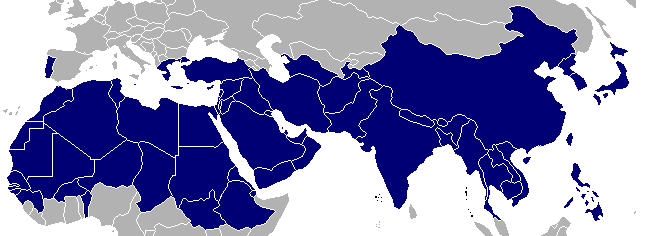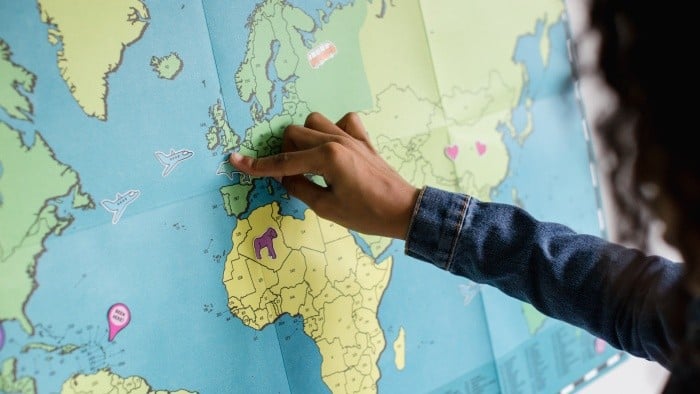The term “10/40 window” was first used in 1990 by Christian missionary strategist, Luis Bush. It represents a rectangular area on a globe between 10 and 40 degrees north latitude. It encompasses North Africa, the Middle East, and Asia. It’s estimated that nearly two-thirds of the world’s population lives within this narrow window-including 90 percent of the poorest people in the world.

Unreached people groups in the 10/40 window
When talking about the 10/40 window, it’s helpful to understand the difference between “unevangelized” and the “unreached.”
A majority of the countries within the 10/40 window are unevangelized, have a limited understanding of the gospel, and have very few opportunities to respond to what they do know. On top of those with little exposure to the good news, this section of the world includes nearly 6,000 unreached people groups-totaling more than 3.05 billion people.
The United States is full of “unevangelized” individuals. These are people who may not have encountered the gospel message, but they do have access to it. They might drive by churches or have access to Christian websites. What they often need are local Christians (or missionaries) who can expose them to the message and give them an opportunity to respond.
“Unreached” people, on the other hand, haven’t heard the gospel because their access to the gospel is extremely limited. This means that for them to hear the gospel, someone needs to cross these cultural and linguistic barriers intentionally.
The 10/40 window represents the world’s largest concentration of both groups.
The countries of the 10/40 window
According to Scripture, the 10/40 window is the birthplace of civilization. It was the home of the garden of Eden and most of the Bible occurs in this small window. Here are the countries that exist within the 10/40 window: Afghanistan, Algeria, Bahrain, Bangladesh, Benin, Bhutan, Burkina Faso, Cambodia, Chad, China, Cyprus, Djibouti, Egypt, Eritrea, Ethiopia, Gambia, Gibraltar, Greece, Greece, Guinea, Guinea-Bissau, India, Iran, Iraq, Israel. Japan, Jordan, North Korea, South Korea, Kuwait, Laos, Lebanon, Libya, Macau, Mali, Malta, Mauritania, Morocco, Myanmar (Burma), Nepal, Niger, Oman, Pakistan, Philippines, Portugal, Qatar, Saudi Arabia, Senegal, Sudan, Syria, Taiwan, Tajikistan, Thailand, Tunisia, Turkey, Turkmenistan, United Arab Emirates, Vietnam, Western Sahara, and Yemen.
Eight out of ten of the world’s poorest people live in the 10/40 window, existing on much less than a few hundred dollars every year. It’s amazing to consider how the world’s poorest countries and the world’s least-evangelized countries exist within the same geographic window.
Jesus Film Project’s Mission 865 to the 10/40 window
The JESUS film has been dubbed into more than 1,700 languages and has resulted in more than 570 million indicated decisions for Christ. But there are more than 865 documented language groups in the world with 50,000 or more speakers, representing roughly 323 million people-many of whom live within the 10/40 window.
The Jesus Film Project® is committed to reaching these groups with the story of Jesus in their own language. Mission 865 is an initiative dedicated to that commitment. Along the way, the JESUS film will be shared with smaller language groups, too.
As of fall 2018, 395 translations of the JESUS film have been completed. A number of those language groups exist in the 10/40 window, including people in countries like:
- Egypt
- India
- Ethiopia
- Iran
- Mali
Thanks to Mission 865, we’ve already been able to reach more than 204 million people with the story of Christ.
Get involved!
If you’re interested in helping us meet this important goal, there are a number of ways you can participate. You can donate toward the work of translating the JESUS film, or you can make a more specific purchase from the Jesus Film Project gift catalog.
We also need people committed to praying for the ministry of Jesus Film Project. For more information, visit JesusFilm.org/how-to-help/pray.
Help us reach the world’s unevangelized and unreached people.
